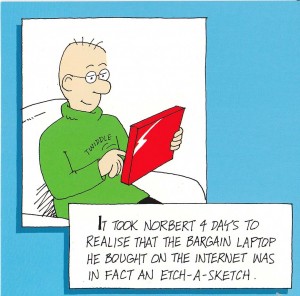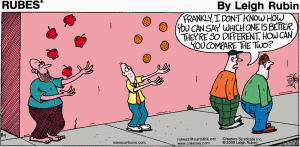Mind the gap…Tips for good product management
Caller: “Hello, is this Tech Support?”
Tech Rep: “Yes. it is. How may I help you?”
Caller: “The cup holder on my PC is broken and I am within my warranty period. How do I go about getting that fixed?”
Tech Rep: “I am sorry, but did you say a cup holder?”
Caller: “Yes, it’s attached to the front of my computer”
Tech Rep: “Please excuse me if I seem a bit stumped, it’s because I am. Did you receive this as part of a promotional, at a trade show? How did you get this cup holder? Does it have any trademark on it? ”
Caller: “It came with my computer, I don’t know anything about a promotional. It just has ‘8x‘ on it.”
The caller had been using the load drawer of the CD-ROM drive as a cup holder and snapped it off the drive.
[This story was attributed to George Wagner, Greenberg,1971]
You might have read this earlier and laughed it off. I started this post with this very naive-sounding, but true conversation that happened between a PC user and a customer service representative. Today, I wish to touch upon the widening gap that prevails between the management and stakeholders of product companies and the needs and conceptual models of end-users. As a product manager, its all the more important to understand the existence of this divide between the creators & consumers and try to plug this ever widening distance!
First, identify the people involved
First things first, define the roles of the people involved in the process of product creation and consumption. To keep it simple, we can classify them into three different categories – stakeholders, customers and users. These can be people, groups of people, entities or even organizations. They can be separated physically and logically into different classes, but sometimes there could be an overlap or common areas amongst a few of them. For instance, in a product company such as an automotive manufacturing, sometimes the stakeholders and customers could be the same as the company might be manufacturing the components which are consumed by the same company in building a car.
What do you want to be and want to do
Stakeholders are those people who have a direct or indirect influence on and who get benefited from the product, solution or service under development. One might argue that customers and users are very much part of the stakeholders. Yes, they are, but since they hold bigger stake of your product, you can classify them under a separate category. For simplicity’s sake, include in this category of stakeholders…management, product development team, client, vendors, partners, venture capitalists, and all those involved in the process of product creation.
You need to identify the key stakeholders in the form of individual persons from within the groups. Have one-to-one interactions with each of the identified stakeholders. During these interactions, extract the various perspectives depending on their roles and profiles. For example, from a CEO, get a business perspective, whereas from a CTO understand the technical perspective and from a Business Development Director, get the views on customers and competing companies.
Define the ‘Identity’ – Inner view
The sum total of the vision, challenges, constraints, expectations, views about competitions, products, business, technology etc. from each of the key stakeholders provides the composite identity of the organization or the product under discussion. You might notice that within the same organization, and on the same area or point, there might be conflicting views and expectations from different stakeholders. However, this should not be a stumbling block, but instead try and understand why these differences are cropping up and resolve them with the involvement of stakeholders.
I am reminded of the marketing assignment which I did during my MBA summer-project. It was with a company which is into biscuits,cookies and dairy products. They just re-positioned their brand and brought out a whole range of products aligned to their new identity. The company’s stakeholders thought that the brand and the products they create not only support the health and well-being of the consumers but also enhance their thinking and intellectual capabilities. So, they started massive campaigns all around the country brandishing those perceived values, strengths and greatness of the brand and product. Read through the next few paragraphs to know the outcome of my studies.
Customers and users may not be the same
In the case of services, mostly customers and users could be the same, but in the context of products and that too for enterprise and B2B products and services, these two groups invariably differ, to a large extent. In fact, even within the same group say customers, you have different variations such as decision makers who hold the purse strings, and purchasers who execute the deal.
No ‘Average Joe’ in users
The ‘law of averages’ might work in almost all the places but not in product innovation and user experience management. Bear in mind that there is no average user or stereotypical user, for whom if you design and develop your product, it works across all the potential users. Similarly within the users, there may be many different sub-groups based on tasks, work profile, experience, education, and other demographics. You just cannot assume that all the users are same and have the same needs, wants and challenges.
Understand the ‘Image’ – External view
Another critical component is to understand the external perspective, that of the customers and users about your product. This is what I refer to as image of the organization or the product. Often times, this image is formed in the minds of the users through various ways. Some of these could be the interactions that users have with your company or product, experiences formed through usage of this or similar products earlier, advertising and promotions, interactions with friends, peers and family about the product etc.
Sometimes the image formed about the product need not be real at all and instead was formed from incorrect perceptions and misconceptions. Again this could be due to various reasons such as users themselves( demographics such as education and experience), your product (promotion, design of the product, and its promotions) or both.
Referring to the biscuit company case of my assignment, I did a lot of user research talking to users, understanding their mental models, conducting some market research to know their perceptions, preferences etc. All these studies led me to a very strange set of results. The consumers of this specific brand and products, don’t really see anything healthy in the products, nor do they associate it with their thinking well or intelligence. They had a completely different sense of what these products stand for and do
Gap = Identity ~ image
You defined the identity for your product from stakeholders’ view and also understood its image among your customers and users. By now, you would have realized that they are not exactly matching and that there is a difference between the identify and the image. Often times the success or failure of the product is decided by the extent of this gap. The focus now shifts to measure the extent of this gap, both qualitatively and quantitatively. Then the next steps are to understand the root causes for the gap and taking corrective and preventive actions.
Going back to my project work on the biscuits company, I analyzed the results and found that there was a huge gap between the company’s vision and consumers’ view of the products. After further analysis, I could get to the bottom of the case and understood the real reasons to be lack of customer awareness, increasing focus on competition, new management oblivious to the ground realities of the industry and the market needs etc.
Here is how to plug the gap
To ensure that your product works well for the key primary users, follow the guidelines I give below. These are based on industry standard best practices and also from my experience from the past success stories. Note that each of the steps can be explained and expanded into a separate blog post or even a separate chapter in a book. I am just giving them in a list so that we can focus on the specific topic of this post.
- Create user profiles
- Select no more than 3 user profiles as your primary target user groups
- Create personas
- Understand the conceptual models of users
- Identify the key needs, challenges, pain areas of the users
- Understand the key tasks that they do
- Define the breakdown scenarios, and workarounds used in doing these tasks
- Use the personas extensively throughout your product development
- Scope the features and functionality of your product, around the personas
- Design and develop your product around the needs
- Keep stakeholders, customers and users involved throughout product development
- Go back to these people on a continual basis with whatever you have developed
- Try and identify the gaps, problems, and areas of improvement
I hope this post would help you form a vision for your product, reach out to your users, understand and bridge the gap between the two. And by doing all of these, you are increasing the chances of developing a successful product. Till next post, ciao!



Responses